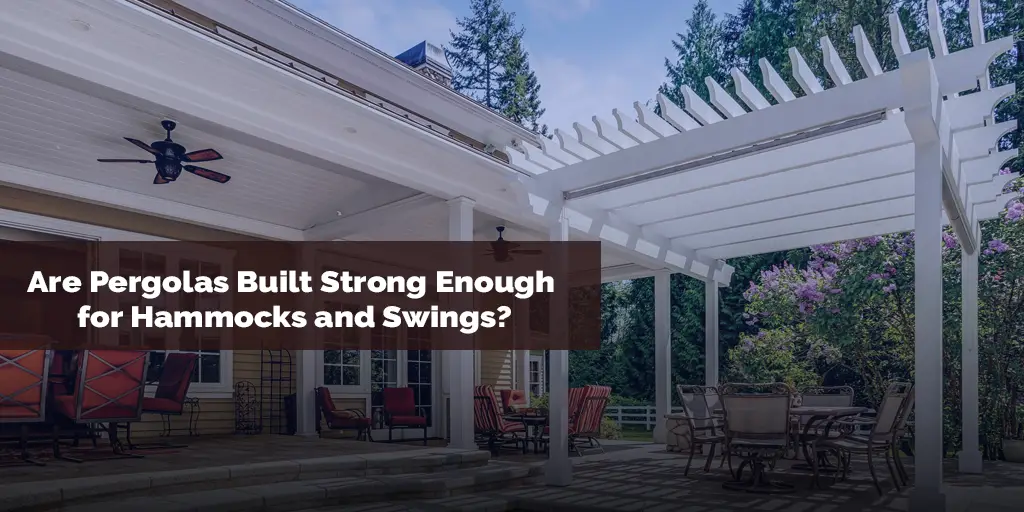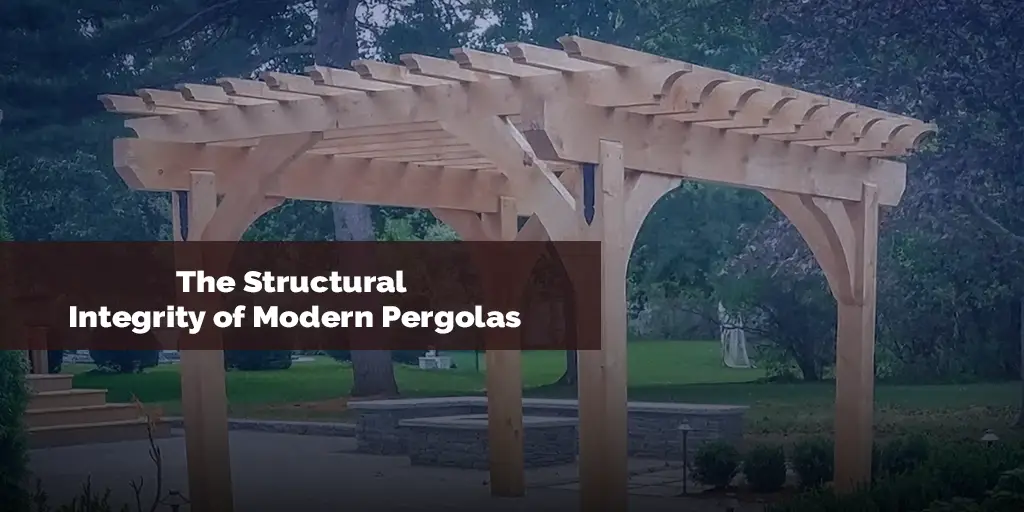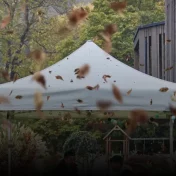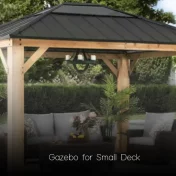Hammocks and swings have long been associated with relaxation, tranquility, and the simple joys of outdoor life. Whether you’re imagining:
- Cradling comfortably in a super-tropical hammock, feeling the world fade away.
- Swaying gently back and forth, letting the soft garden breezes take away the day’s stress.
- Cozying up on a pendulous porch swing, watching the world go by.

These are not just pieces of outdoor furniture; they are gateways to a more peaceful and relaxed state of mind. But the question arises, where do you hang them? The answer for many has been pergolas. But are they up to the task?
The Big Question: Can Pergolas Support Them?
Pergolas, with their elegant designs and sturdy structures, have become a staple in many gardens and patios.
However, as hammocks and swings grew in popularity, so did a frequently asked question: “Can my pergola support the weight of a hammock or swing?”
The answer, in most cases, is a resounding “Yes!” But, as with everything, there are certain considerations to keep in mind:
- Material & Construction: Not all pergolas are created equal. While most modern pergolas are designed to be robust, the material (wood, metal, vinyl) and the quality of construction play a significant role in its strength.
- Anchoring & Support: Even the sturdiest pergola needs proper anchoring. Ensure that it’s firmly rooted to the ground or attached securely to a deck or patio.
- Weight Limits: Always check the manufacturer’s guidelines on weight limits. While many pergolas can easily support the weight of an adult in a hammock, it’s always better to be safe.
- Additional Reinforcement: If you’re unsure about your pergola’s strength, consider adding additional beams or supports. This not only ensures safety but can also add to the aesthetic appeal.
Remember, safety first! While it’s tempting to simply hook a hammock onto the nearest beam and jump in, taking a few precautions can ensure a relaxing experience without any unpleasant surprises.
The Structural Integrity of Modern Pergolas

The modern pergola has come a long way from its ancient counterparts. While they retain the elegance and charm of the classic pergola, today’s structures are built with a blend of traditional craftsmanship and advanced engineering.
Factors Contributing to the Strength of Pergolas:
- Design Innovations: Modern pergolas often incorporate designs that distribute weight more evenly, reducing stress on individual beams.
- Quality of Materials: Whether it’s resilient hardwood, rust-resistant metal, or durable vinyl, the materials used in today’s pergolas are chosen for their strength and longevity.
- Advanced Joinery Techniques: The way beams, posts, and rafters are joined together plays a significant role in the overall strength. Techniques like mortise and tenon joinery or the use of heavy-duty brackets ensure a tight and secure fit.
- Protective Coatings: Many pergolas come with protective coatings that shield them from the elements, reducing wear and tear and maintaining structural integrity.
Case Study: The Lasting Pergola
Consider the story of Mr. James from Arizona. He installed a hardwood pergola in his backyard about a decade ago. Over the years, it has faced scorching sun, heavy rains, and even a hailstorm.
Yet, with regular maintenance, not only has the pergola retained its beauty, but it has also supported various swings and hammocks that his family has enjoyed. It stands as a testament to the durability and strength of well-crafted modern pergolas.
Dive into Timber Frame ShadeScape® Kits
When talking about the pinnacle of pergola strength and design, it’s impossible not to mention Timber Frame ShadeScape® Kits.
These kits exemplify how ancient craftsmanship can seamlessly merge with modern technology to produce structures of unparalleled strength and beauty.
Why ShadeScape® Stands Out:
- The Dovetail Difference®: One of the standout features of these kits is the patented “The Dovetail Difference®”. This unique joinery method ensures that the beams and posts fit together perfectly, distributing weight evenly and enhancing the overall structural integrity.
- Old-world Craftsmanship: Each kit is crafted with techniques that have been passed down through generations. This ensures that while you get a product of modern engineering, it still retains the charm and durability of traditional structures.
- Easy Installation: Despite their robustness, ShadeScape® kits are designed for easy and quick installation. Whether you’re a DIY enthusiast or prefer professional installation, setting up is a breeze.
- Customization: One of the strengths of ShadeScape® is the range of customization options available. From design variations to material choices, you can truly make your pergola uniquely yours.
Comparison of Pergola Kits
| Feature | ShadeScape® Kits | Standard Kits |
|---|---|---|
| Joinery Method | The Dovetail Difference® | Basic Screws & Bolts |
| Installation | Fast & Simple | Can be Time-Consuming |
| Craftsmanship | Old-world Techniques | Modern Assembly Line |
| Customization | High | Limited |
By understanding the features and benefits of Timber Frame ShadeScape® Kits, it becomes clear why many homeowners and professionals alike consider them the gold standard in pergola design.
The Architectural Brilliance Behind Pergolas
The strength of a pergola isn’t just derived from the materials used or the joinery techniques applied; it’s also a result of the underlying architectural principles. Pergolas are architectural marvels that combine aesthetics with functionality.
Key Architectural Features of Pergolas:
- Grid Pattern Roofs: A common design feature in many pergolas is the grid pattern roof. This design ensures that the weight from any suspended items, like hammocks or swings, is distributed evenly across the structure.
- Knee Braces for Stability: These diagonal braces, connecting posts and beams, provide lateral support, ensuring the pergola remains stable and doesn’t sway with wind or the dynamic weight of a swing.
- Crossing Rafters and Top Shade Planks: The interlocking pattern created by these elements not only provides shade but also adds to the rigidity of the structure.
- Variable Post Spacing: Depending on the design, the spacing between the posts can be adjusted to provide additional support where needed.
Did You Know? Historically, pergolas were used in gardens to provide a shaded pathway or sitting area. They were often adorned with climbing plants and flowers, creating a naturally shaded, fragrant retreat.
This historical usage underscores their strength; they were designed to support not just the weight of plants but also the occasional snowfall or other environmental factors.
In essence, while pergolas are undeniably beautiful, their design is rooted in practicality and strength, ensuring they stand the test of time and usage.
You May Also Enjoy Reading: what is the best hardtop gazebo to buy
How Other Outdoor Enthusiasts Are Leveraging Their Pergolas
While the primary discussion revolves around the strength of pergolas in supporting hammocks and swings, it’s essential to understand the versatile ways in which homeowners and outdoor enthusiasts are utilizing these structures.
Innovative Uses of Pergolas:
- Suspended Dining Tables: Imagine a floating table setup under the canopy of your pergola. It not only serves as a unique dining experience but also becomes a conversation starter.
- Hanging Planters: For those with a green thumb, pergolas offer the perfect framework to hang planters, creating a lush, green canopy overhead.
- Suspended Daybeds: Why stop at hammocks and swings? Some homeowners have taken it a step further by suspending full-sized daybeds, creating the perfect outdoor nook for relaxation or even a night under the stars.
- Outdoor Workspaces: With the rise of remote work, many have turned to their pergolas as outdoor offices. The shade and structure provide a comfortable environment to work in, with the added benefit of fresh air.
Real-life Experience:
Sarah from California shares, “My pergola has been a lifesaver during the pandemic. Initially installed to support a couple of swings, it soon became my outdoor office.
The strength and stability of the structure allowed me to add shelves, a suspended desk, and even a hanging chair. It’s my favorite spot in the house now!”
Pergolas, with their strength and architectural beauty, are not just frameworks to hang swings or hammocks; they are blank canvases waiting for homeowners to imprint their creativity.
Conclusion: The Strength and Elegance of Pergolas
Pergolas have stood the test of time, proving their worth not just as decorative structures, but as robust frameworks capable of supporting a range of suspended items.
From the simple joys of a hammock to the innovative uses like suspended dining tables, pergolas have shown their versatility and strength.
Understanding the architectural principles, the quality of materials, and the craftsmanship that goes into building a pergola can give homeowners the confidence to experiment and leverage their pergolas to the fullest.
So, the next time you gaze at your pergola, see it not just as a structure, but as an opportunity—a canvas waiting for your touch.
Whether it’s a swing, a hammock, or something more innovative, trust in the strength of the pergola and let your creativity run wild.



